Varieties and properties of plastic wall panels

Plastic panels are versatile finishing materials that are great for wall decoration. They are moisture resistant, durable and unpretentious. Many consumers choose plastic for finishing ceilings, since it can be not only monochromatic, but also multi-colored and repeating various materials of natural origin.


Peculiarities
Plastic is one of the most popular materials. It is used in the manufacture of a wide variety of products. It does not rot, does not suffer from contact with water and does not require complex maintenance.
Thanks to such distinctive characteristics, plastic is ideal for the manufacture of high-quality finishing materials. Currently, plastic panels are very popular, as they are not only practical, but also very attractive.
The range of such products is huge today. You can choose beautiful coatings for every taste, color and budget. In stores you can find plain, multi-colored and canvases with various patterns. We should also highlight the popular panels that imitate various materials. For example, it can be masonry, brickwork or wood.


Plastic panels can be installed in almost any room. It can be not only a dry and warm living room, but also a bathroom or kitchen. The main thing is to choose a high-quality canvas that will last a long time and will not lose its attractive appearance.
Wall plastic panels are also distinguished by a rather simple installation - even an inexperienced home craftsman can handle it.
Such finishing materials can be used in any interior. It can be both classic and modern furnishings. It is not recommended to install plastic panels in an elaborate setting (baroque, rococo, empire style) - the plastic will stand out sharply from such an ensemble, making it disharmonious.



Advantages and disadvantages
Plastic panels are popular and demanded finishing materials. The relevance of such a cladding is explained by many advantages.
- Plastic panels are durable materials. They are not afraid of moisture and dampness. Thanks to this quality, the finish can be safely used when decorating a bathroom or kitchen.
- High-quality plastic panels retain their original appearance for many years.
- Such a finish does not require complex and regular maintenance. Plastic does not accumulate dust and dirt. If stains appear on its surface, then you do not have to purchase special and expensive compounds to remove them - most of the dirt from plastic panels can be removed with an ordinary damp cloth.
- Plastic panels are inexpensive. That is why many consumers choose this finish option. It will cost several times cheaper than decorating walls with tiles or wood.

- Wall panels made of plastic can boast of good soundproofing qualities.
- The installation of such finishing materials is simple and quick. It can be produced without the involvement of specialists, which can significantly save money.
- With the help of PVC panels, you can zoning the existing space.
- Such finishing materials are lightweight, so it is easy and convenient to work with them.
- Plastic is a material that is very easy to process. Due to this quality, these coatings are represented by a fairly rich assortment. To decorate a room, you can pick up canvases with absolutely any images and colors.


- Plastic is a safe material. Even at high temperatures, it does not emit hazardous or harmful substances. However, when buying panels, you should ask the seller for a quality certificate and make sure that there are no toxic compounds in the plastic, since such components can still be contained in low-quality material.
- You can install finishing materials not only in city apartments, but also in private houses. In addition, they are well suited for installation in confined spaces.
- With the help of such a material, many floor defects can be hidden: cracks, drops, potholes, depressions and other flaws.
- Various communications, such as electrical wiring, can be hidden behind plastic panels.

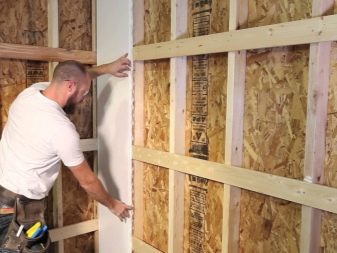
Despite the large list of positive qualities, plastic wall panels also have their weaknesses.
- The material is highly flammable. In the event of a fire, this product burns very intensely and emits suffocating smoke in the room.
- In a room with a plastic finish, a characteristic chemical smell can persist for a long time. But here it is worth noting that many owners did not notice such a defect.
- Plastic panels do not tolerate temperature extremes. In such conditions, they can undergo deformation.
- Plastic itself is not the most reliable and durable material. Panels made from such raw materials can break from accidental impact or severe stress.


- These products are not breathable finishing materials. They prevent the movement of air through the walls, and this is simply necessary for high-quality ventilation. For this reason, experts do not recommend installing such coatings in children's rooms.
- The voids that are present in plastic panels can be a home for insects. This problem is especially relevant for the southern regions of the country.
- Before installing the cladding material, it is necessary to carefully prepare the floors. Many masters consider this fact as a disadvantage, since it takes a lot of time.


Properties and characteristics
Plastic or PVC panels are products made from polyvinyl chloride - an organic material, which contains 3 main components.
- chlorine (percentage of its content - 75%);
- carbon (42%);
- hydrogen and various impurities (1%).
Previously, a small amount of lead was added to the feedstock - it played the role of a material stabilizer. Currently, zinc and calcium are used in equal proportions instead of lead.



The service life of plastic wall panels in our climate is about 10 years.
Modern manufacturers produce canvases with various operating temperature ranges. For example, some types of panels can be used at temperatures from -30 to +80 degrees.
Various images and prints are applied to plastic panels using photo printing. Typically, these add-ons are durable and durable. They can withstand aggressive sunlight without problems and do not fade under their influence.
Often during the production process, plastic panels are treated with a protective lacquer coating. It makes the material more wear-resistant and not subject to abrasion. In addition, lacquered items are much more difficult to scratch. They are very easy to clean from dirt.

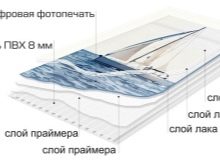

Plastic wall panels can be used exclusively for interior decoration.They should be in a room that is not exposed to sudden temperature changes during the day.
Similar materials can be used to decorate a loggia or balcony, since such products are frost-resistant.

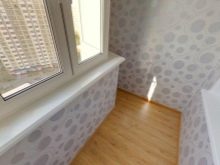

The strength of plastic panels directly depends on the percentage of polyvinyl chloride in them. Wall coverings are more durable than ceiling coverings. As a rule, they are about 8 mm thick. Such a material is not flexible - it is rather rigid and not designed for bending, but it is more resistant to mechanical stress.
Also, the number of ribs affects the strength properties of the panels. It should be borne in mind that these elements should not be visible through the front side.


Views
In stores you can find PVC wall panels of different types.
- Vinyl lining. Such wall coverings are the most common and in demand. They are in great demand and are found in almost all stores selling finishing materials.
- PVC lining is a rectangular sheet. Their length is 3-12 cm, width - 0.1-0.5 m, thickness - 8-12 mm. Such wall coverings can be used for almost any work. White lining is most often found in stores, other colors are very rare.


- Sheets. The second most popular are plastic sheets. Such materials are more impressive in size. The exact measurements of length, width and thickness depend on the manufacturer who produced this material. The good thing about plastic sheets is that there are no joining seams in them. Installation of such coatings can be carried out directly on the floor surface.
Some of the most common are plastic sheets, the surface of which imitates tiled masonry. Such coatings are often used in the decoration of walls in a bathroom or an apron in the kitchen.
- Sandwich panels. High-quality sandwich panels made of polyvinyl chloride can boast of an enviable demand today. Such materials have a beautiful appearance. With the help of such a decoration, you can transform the room beyond recognition.

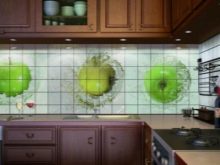

- Thin. Most plastic panels consist of two layers, connected by jumpers. Such materials have many advantages, but their main disadvantage is their low strength: if they are hit or pressed hard on their surface, then these products can get serious damage. Most often, it is because of this that consumers refuse to buy such coatings. Manufacturers decided to remedy this situation by launching thin plastic canvases on the market. They have no cells and can be as little as 3 mm thick. Such materials are a thin layer of plastic with a pattern applied to it. Thin PVC panels and panels are easily fixed on the walls - they just need to be glued to the ceiling.
It is possible to use such materials even in small rooms, since they do not “eat up” extra centimeters of free space.


- Lacquered. On these types of PVC panels, drawings and ornaments are applied by thermal transfer and offset printing. To make the images more wear-resistant and durable, they are covered with an additional layer of varnish. It protects the prints on the panel from fading and cracking. After transferring the image, the texture of such a plastic sheet can be matte, ideally smooth and silky or glossy.
- Laminated. These types of products are the most common. A decorative film is applied to them, which effectively imitates various materials - stone, wood, granite, brick and other surfaces. In addition to imitating a variety of materials, laminated panels can be decorated with beautiful patterns and prints. These products are durable and abrasion resistant.


- With 3D effect. If you need more original finishes, then you should take a closer look at spectacular plastic panels with 3D photo printing. On the surface of such materials, there may be an imitation of gypsum stucco molding, tiles, natural compositions and various ornaments. These products are more expensive, but they look interesting and fresh.



Dimensions, shape and decor
Plastic wall panels are available in different lengths, widths and thicknesses.
- vinyl lining has a rectangular shape: length - 3-12 m, width - 0.1-0.5 m and thickness - 8-12 mm;
- plastic sheets are larger and wider: the length is from 1.5 to 4 m, the width is up to 2 m, the thickness is up to 3 cm;
- the length of sandwich panels is most often 3 m, width - from 0.9 to 1.5 m, thickness - 10-30 cm.
As a rule, plastic panels are square and rectangular, less often diamond-shaped parts. In stores, you can also find canvases with embossed edges - most often this way wall sheets are made that imitate masonry or brickwork, in which individual elements stand out slightly more than others.


Plastic wall panels come in various designs. For example, mirror PVC tiles on a self-adhesive base look beautiful and neat. Such materials are a good alternative to glass tiles with a reflective surface - firstly, they are much cheaper, and secondly, they are not as fragile.
Also today, embossed panels with a 3D effect are very popular. and beautiful openwork coatings. Such canvases do not look simple and cheap, because with their help you can give the interior a special charm and emphasize its style.
The canvases, which are decorated with silk-screen printing, have an attractive appearance. These panels, which have a calm and neutral color, are perfect for decorating bedrooms and cozy living rooms.



In addition, plastic panels can be painted in a wide variety of colors.
Today, the most popular and relevant are:
- white;
- beige;
- peach;
- cream;
- pale pink;
- light chocolate;
- caramel tones.
Such coatings easily fit into most interiors, as they have a neutral and classic color. Moreover, with the help of light panels, you can visually expand the space, making it airy.


Of course, in stores you can also find brighter, more saturated PVC panels in juicy colors. Unusual canvases with surfaces, the color of which imitates bronze, gold and silver, are in great demand today. They have beautiful sparkles that sparkle spectacularly in the sun's rays.
Often, one plastic panel combines several different colors and shades at once. For example, it can be a simple white canvas decorated with contrasting black patterns or a bright pink panel with more delicate peach ornaments.

In addition, PVC wall panels are available in different textures:
- matte;
- glossy;
- smooth;
- rough.


Criterias of choice
Today, in stores selling finishing materials, you can find plastic wall panels of various modifications. Finding the perfect coatings is quite difficult due to the rich assortment of such products.
Below are the selection criteria for plastic wall panels.
- Application area. All plastic panels are subdivided into ceiling and wall panels. Outwardly, such materials are equivalent, but the second options are considered more durable and reliable. It is not worth buying ceiling sheets for finishing floors if they are much cheaper.
- Panel sizes. For large walls, appropriate panels are most often purchased, and for small walls, miniature ones, for example, vinyl lining. Before heading to the store, it is recommended that you measure all substrates that need to be finished with plastic.
- Temperature resistance. Experts recommend purchasing more wear-resistant PVC panels that are resistant to temperature extremes. This criterion is especially important if you plan to decorate a balcony or loggia with such materials.

- Design. Plastic panels must fit perfectly into the environment for which they are purchased.
- Environmental Safety. When buying plastic panels, it is imperative to request a quality certificate for the product. It should be carefully examined. The plastic should not contain hazardous chemicals.
- Product quality. Before purchasing, be sure to make sure that the plastic panels are safe and sound. If there are damages, chips or scratches on the surface of the finish, then it is better to refuse to buy such coatings.
- Manufacturer. You should not look for too cheap PVC panels, since such finishing materials already have an affordable cost. You need to purchase branded products - as they are of excellent quality.

Features of finishing works
Plastic wall panels are a non-capricious material that is quite possible to install with your own hands.
Below are some of the features related to such finishing work.
- Before installing the plastic, it is necessary to prepare the floors. They need to be freed from old coatings, hide all cracks, level out the drops and coat the base with an antifungal compound. If it is planned to install plastic panels on the frame, then this stage of work is optional.
- Then you need to mark the walls. Install the crate with a level to avoid distortions. The bottom row of the battens should be 1-2 cm above the floor. At this point, you need to make a mark with a pencil, and then draw a horizontal line from it along the entire perimeter.
- A similar line is drawn under the ceiling if it is decided to sheathe the floor to the full height.
- After that, you need to measure 48-50 cm from the bottom line and put a beacon - this should be done to the very top.
- The panels must be fixed perpendicularly to the lathing, therefore horizontal structures are sheathed vertically, and vice versa.


- After the markings have been completed, you can mount the crate. For this, wooden slats or metal guides are suitable.
- For metal rails, you need to additionally buy fasteners - such elements are attached to the base with self-tapping screws on dowels.
- Wooden frames must be treated with antiseptic compounds before laying the plastic.
- Having installed the frame, you can proceed to the installation of the panels. The first part should be fixed in the far corner from the entrance. If necessary, the panel is trimmed with a hacksaw - an outstanding thorn is cut off.
- After that, with the cut side, it must be inserted into the corner profile, and then installed into the upper and lower element. After that, the plastic panel must be driven into the groove until it stops. You can check the evenness of the installation using a level, and then proceed to further steps.
- After attaching the launch pad, you can mount the second element. It is docked with the first and securely fixed. The actions must be repeated until all the panels are laid out on the frame.


Installation of PVC panels can be done without a frame. To do this, use self-tapping screws or a special adhesive (for example, liquid nails).
Such mounting methods cannot be called universal:
- with such an installation, the finishing material may undergo deformation;
- if necessary, it will be difficult to replace an individual element.
With a frameless installation method, the floors must be carefully prepared.
It is imperative to get rid of any defects, damage, cracks and irregularities, otherwise the plastic panels will not adhere securely to the walls. Moreover, they can accentuate their curvature.


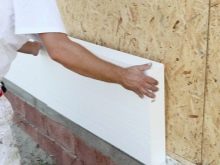
To fix the plastic panels, it is necessary to select transparent glue, from which there will be no streaks. In addition, it must be moisture resistant, especially if it is planned to be installed in a kitchen or bathroom. The adhesive should be applied to the substrate in a checkerboard pattern in large drops. For such work, it is recommended to purchase quick-drying glue. After laying on it, the plastic will fix quickly and efficiently.

Examples in the interior
Plastic cladding materials look organically in different rooms: hallway, living room, bathroom or kitchen. The place of installation of such coatings depends only on the personal preferences of the owners.
Today, original plastic 3D panels are very popular. Accent walls can be decorated with such coatings. For example, it can be a ceiling in the living room with a TV installed or a partition opposite which there is a dining table with chairs in the kitchen.


Plastic panels look harmonious in the hallway or corridor. Most often, coatings that imitate stone and wood are installed here - against such a background, almost any models of entrance and interior doors look organically.
Also in such conditions, you can use a combination of plastic panels for a stone or brick and wallpaper. It is recommended to use lighter coatings in the hallway and corridor, as otherwise these rooms may seem too cramped and "oppressive".


For the bathroom, plastic panels for tiles or openwork canvases are perfect. With the help of such finishing materials, you can give such rooms an airy and harmonious appearance. You can install PVC panels in a variety of colors in the bathroom. For example, white technique will stand out against the background of black lacquered finishing materials. Walls in this vein can be supplemented with more mirrors to make the space seem more spacious and shiny.


If it is necessary to make the bathroom lighter and more positive, then it is worth choosing PVC coatings that imitate tiles in delicate tones. For example, pale purple paints decorated with images of purple flowers will look harmonious in a bathroom with a pale pink floor, wooden cabinets and a tall shower cubicle with glass partitions.

With PVC stone panels, you can lay out the wall behind the seating area in the living room. The shade of this finish should match the color of the rest of the floors and furniture. For example, in a hall with white or dull lemon ceilings, as well as a beige leather sofa, panels under a sand-colored stone will look organic.
In the kitchen, an apron can be decorated with plastic panels. For example, in a snow-white room with a black and white set, a canvas with images of crops and kitchen utensils, made in brown tones, will look spectacular.


For instructions on installing plastic panels, see the video below.













The comment was sent successfully.